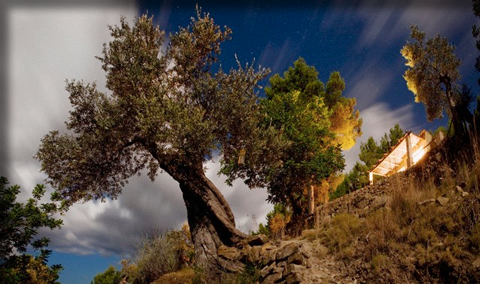
ΕΛΛΗΝΙΚΗ ΔΗΜΟΚΡΑΤΙΑ
ΠΕΡΙΦΕΡΕΙΑ ΠΕΛΟΠΟΝΝΗΣΟΥ Ναύπλιο 18 – 03 -2014
ΓΕΝΙΚΗ Δ/ΝΣΗ ΠΕΡΙΦΕΡΕΙΑΚΗΣ
ΑΓΡΟΤΙΚΗΣ ΟΙΚΟΝΟΜΙΑΣ
& ΚΤΗΝΙΑΤΡΙΚΗΣ
Δ/ΝΣΗ ΑΓΡΟΤΙΚΗΣ ΟΙΚΟΝΟΜΙΑΣ
& ΚΤΗΝΙΑΤΡΙΚΗΣ ΠΕΡΙΦΕΡΕΙΑΚΗΣ
ΕΝΟΤΗΤΑΣ ΑΡΓΟΛΙΔΑΣ Προς: Μ.Μ.Ε
Ταχ.Δ/νση: Παρ. Οδός Ναυπλίου-Ν. Κίου Ν. Αργολίδας
Ταχ. Κωδ. : 21100 Ναύπλιο
Τμήμα: Ποιοτικού & Φυτ/κού Ελέγχου
Πληρ: Δημ. Δήμου-Κ. Σπανού
Τηλέφωνο: 2752360304
Fax:27520-26250
Ε-mail:agro_fyt@argolida.gr
ΠΕΡΙΦΕΡΕΙΑ ΠΕΛΟΠΟΝΝΗΣΟΥ Ναύπλιο 18 – 03 -2014
ΓΕΝΙΚΗ Δ/ΝΣΗ ΠΕΡΙΦΕΡΕΙΑΚΗΣ
ΑΓΡΟΤΙΚΗΣ ΟΙΚΟΝΟΜΙΑΣ
& ΚΤΗΝΙΑΤΡΙΚΗΣ
Δ/ΝΣΗ ΑΓΡΟΤΙΚΗΣ ΟΙΚΟΝΟΜΙΑΣ
& ΚΤΗΝΙΑΤΡΙΚΗΣ ΠΕΡΙΦΕΡΕΙΑΚΗΣ
ΕΝΟΤΗΤΑΣ ΑΡΓΟΛΙΔΑΣ Προς: Μ.Μ.Ε
Ταχ.Δ/νση: Παρ. Οδός Ναυπλίου-Ν. Κίου Ν. Αργολίδας
Ταχ. Κωδ. : 21100 Ναύπλιο
Τμήμα: Ποιοτικού & Φυτ/κού Ελέγχου
Πληρ: Δημ. Δήμου-Κ. Σπανού
Τηλέφωνο: 2752360304
Fax:27520-26250
Ε-mail:agro_fyt@argolida.gr
ΔΕΛΤΙΟ ΤΥΠΟΥ
Θέμα: Η προσβολή των ελαιώνων της Ν. Ιταλίας από το βακτήριο Xylella fastidiosa και ο κίνδυνος εξάπλωσης του στις καλλιέργειες της Ελλάδας
…Το βακτήριο Xylella fastidiosa είναι ένας επιβλαβής οργανισμός καραντίνας που εντοπίστηκε τον Οκτώβριο του 2013, στην Νότια Ιταλία σε δύο διαφορετικές περιοχές της επαρχίας Λέτσε(Lecce), στην Περιφέρεια της Απουλίας(Apulia).Η παρουσία του είναι εντυπωσιακή αφού βρέθηκαν να έχουν μολυνθεί περίπου 80.000 στρέμματα ελαιοδέντρων. Επίσης επιβεβαιώθηκε η εμφάνισή του στην αμυγδαλιά, σε φυτά πικροδάφνης και δένδρα βελανιδιάς. Τα συμπτώματα χαρακτηρίζονται από «καψίματα» στα φύλλα και ταχύτατη αποπληξία(ξήρανση) των δένδρων. Πρόκειται για την πρώτη αναφορά επιβεβαιωμένης παρουσίας του συγκεκριμένου επιβλαβούς οργανισμού στην επικράτεια της Ευρωπαϊκής Ένωσης.
Σε παγκόσμιο επίπεδο ο επιβλαβής αυτός οργανισμός έχει αναφερθεί ότι προσβάλλει περισσότερα από 100 διαφορετικά είδη φυτών, όπως ελιές, εσπεριδοειδή (Εικ.8), αμπέλια (Εικ. 5-6), ροδακινιές, αχλαδιές, δαμασκηνιές, βυσσινιές, μουριές, μηδική καθώς και δασικά δένδρα όπως τη βελανιδιά, τη φτελιά, το σφεντάμι και θάμνους όπως η πικροδάφνη(Εικ.7). Επιπλέον πολλά άγρια χόρτα, ζιζάνια, και θάμνοι μπορεί να φέρουν το βακτήριο χωρίς να δείχνουν συμπτώματα.
Σε παγκόσμιο επίπεδο ο επιβλαβής αυτός οργανισμός έχει αναφερθεί ότι προσβάλλει περισσότερα από 100 διαφορετικά είδη φυτών, όπως ελιές, εσπεριδοειδή (Εικ.8), αμπέλια (Εικ. 5-6), ροδακινιές, αχλαδιές, δαμασκηνιές, βυσσινιές, μουριές, μηδική καθώς και δασικά δένδρα όπως τη βελανιδιά, τη φτελιά, το σφεντάμι και θάμνους όπως η πικροδάφνη(Εικ.7). Επιπλέον πολλά άγρια χόρτα, ζιζάνια, και θάμνοι μπορεί να φέρουν το βακτήριο χωρίς να δείχνουν συμπτώματα.
…Για πολλά χρόνια η παρουσία του βακτηρίου Xylella fastidiosa περιοριζόταν στον Καναδά, στις Η.Π.Α, στην Αργεντινή, στη Βραζιλία, στην Κόστα Ρίκα, στην Παραγουάη και τη Βενεζουέλα. Επιπλέον το 1994 για πρώτη φορά αναφέρθηκε προσβολή σε αχλαδιές στην Ταιβάν και στη συνέχεια το 2000 στην ίδια χώρα σε αμπελώνες. Το παράδοξο είναι πως δεν αναφέρεται στη βιβλιογραφία, ότι η ελιά προσβάλλεται από το βακτήριο. Όμως, η αναφορά το έτος 2010, ότι στην περιοχή του Λος Άντζελες(Η.Π.Α), ελιές ξεραίνονταν ταχύτατα, μετά την εμφάνιση μαραμένων φύλλων και ξερών κλαδιών, οδήγησε τις έρευνες στην αναζήτηση του παθογόνου αίτιου. Δυστυχώς το 2013, επιβεβαιώθηκε η εμφάνιση του καταστροφικού αυτού βακτηρίου στους ελαιώνες της Απουλίας, στη Ν. Ιταλία. Σημειώνεται ότι η περιοχή αυτή βρίσκεται πολύ κοντά στην Ελλάδα στην οποία καλλιεργούνται ευαίσθητες καλλιέργειες όπως είναι η ελιά, τα εσπεριδοειδή και το αμπέλι.
Στην Ελλάδα μέχρι σήμερα δεν έχει εντοπιστεί το παθογόνο αυτό, ενώ η παρουσία του δεν έχει επιβεβαιωθεί στην υπόλοιπη Ευρώπη εκτός της Ιταλίας.
Ο αποτελεσματικότερος τρόπος διασποράς του συγκεκριμένου οργανισμού σε μακρινές αποστάσεις είναι η μετακίνηση από μολυσμένες περιοχές προσβεβλημένων φυτών, προκειμένου να φυτευτούν σε άλλες περιοχές. Επιπλέον, το βακτήριο μεταδίδεται από τα μολυσμένα φυτά στα υγιή, με έντομα – φορείς, όπως είναι διάφορα τζιτζικάκια και άλλα μυζητικά ημίπτερα (Εικ. 1).Όμως, για την περίπτωση της Ιταλίας δεν έχει ακόμα ταυτοποιηθεί ο φορέας μετάδοσης του παθογόνου αυτού οργανισμού.
Στην Ελλάδα μέχρι σήμερα δεν έχει εντοπιστεί το παθογόνο αυτό, ενώ η παρουσία του δεν έχει επιβεβαιωθεί στην υπόλοιπη Ευρώπη εκτός της Ιταλίας.
Ο αποτελεσματικότερος τρόπος διασποράς του συγκεκριμένου οργανισμού σε μακρινές αποστάσεις είναι η μετακίνηση από μολυσμένες περιοχές προσβεβλημένων φυτών, προκειμένου να φυτευτούν σε άλλες περιοχές. Επιπλέον, το βακτήριο μεταδίδεται από τα μολυσμένα φυτά στα υγιή, με έντομα – φορείς, όπως είναι διάφορα τζιτζικάκια και άλλα μυζητικά ημίπτερα (Εικ. 1).Όμως, για την περίπτωση της Ιταλίας δεν έχει ακόμα ταυτοποιηθεί ο φορέας μετάδοσης του παθογόνου αυτού οργανισμού.

Εικ.1 Τζιτζικάκι – φορέας του βακτηρίου
….Σημειώνουμε ότι στα μολυσμένα δένδρα ελιάς, το βακτήριο αρχικά φράσσει τα αγγεία του ξύλου, εμποδίζοντας τη μεταφορά του νερού και των θρεπτικών στοιχείων, με αποτέλεσμα την καχεκτική του ανάπτυξη και τελικά την ξήρανσή του. Τα αρχικά συμπτώματα είναι ξηράνσεις σε μεμονωμένα φύλλα, που μοιάζουν με «κάψιμο», έπειτα ξηραίνονται οι βραχίονες και ακολουθεί ταχύτατη αποπληξία των δένδρων (Εικ. 2,3,4).Επίσης αναφέρεται μαρασμός του φυλλώματος και των βλαστών, νανισμός και νέκρωση των δένδρων. Πολλά από τα μολυσμένα ελαιόδεντρα στην Ιταλία ήταν μεγάλης ηλικίας, δηλαδή 100 ετών, και παρουσιάζουν εκτός των παραπάνω συμπτωμάτων εκτεταμένο καστανό μεταχρωματισμό των αγγείων του ξύλου.
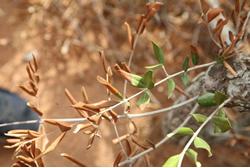 Εικ.2 Αρχικά συμπτώματα «καψίματος» των φύλλων ελιάς σε μεμονωμένα φύλλα.
Εικ.2 Αρχικά συμπτώματα «καψίματος» των φύλλων ελιάς σε μεμονωμένα φύλλα.
Εικ.3 Ξήρανση ολόκληρων βραχιόνων ελιάς

Εικ. 4 Ταχύτατη ξήρανση ελαιοδέντρων
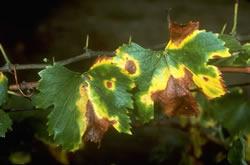
Εικ. 5 . Συμπτώματα στην ποικιλία αμπελιού Chardonnay
(κιτρινίσματα φύλλων, ξηράνσεις)
(κιτρινίσματα φύλλων, ξηράνσεις)
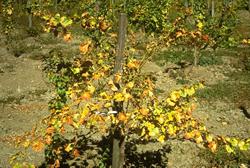
Εικ. 6. Συμπτώματα στην ποικιλία αμπελιού Chardonnay
(κιτρινίσματα φύλλων, ξηράνσεις)

Εικ.7 Συμπτώματα «καψίματος» των φύλλων στην πικροδάφνη.
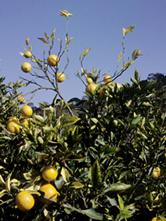
Εικόνα 8. «Ποικιλόμορφη χλώρωση» των φύλλων στα εσπεριδοειδή.
…Αυτή τη στιγμή, η κατάσταση στην Ιταλία είναι κρίσιμη, αφού τα δέντρα που έχουν μολυνθεί προγραμματίζεται να εκριζωθούν και να καούν. Παράλληλα γίνεται μεγάλης κλίμακας κλάδεμα των ελαιοδέντρων, για να αφαιρεθούν τα μολυσμένα μέρη των δένδρων.
…Επιπλέον η Ευρωπαϊκή Επιτροπή με την Εκτελεστική της Απόφαση 2014/87
αναφορικά «με τα μέτρα για την πρόληψη της εξάπλωσης στην Ένωση του οργανισμού Xylella fastidiosa (Wells kai Raju)», απαγόρευσε την κυκλοφορία φυτών ελιάς προς φύτευση από την Επαρχία Λέτσε της Περιφέρειας Απουλία της Ιταλίας.
…Επίσης, για ορισμένα καλλωπιστικά και δασικά φυτά που αναφέρονται στο Παράρτημα I καθώς και κηπευτικά του Παραρτήματος ΙΙ, της 2014/87/ΕΕ Εκτελεστικής Απόφασης της Επιτροπής, από την παραπάνω επαρχία, απαγορεύεται η διακίνησή τους εάν δεν έχουν υποβληθεί σε δειγματοληψίες και επίσημες δοκιμές προκειμένου να διαπιστωθεί ότι είναι απαλλαγμένα από το συγκεκριμένο οργανισμό.
…Επιπλέον η Ευρωπαϊκή Επιτροπή με την Εκτελεστική της Απόφαση 2014/87
αναφορικά «με τα μέτρα για την πρόληψη της εξάπλωσης στην Ένωση του οργανισμού Xylella fastidiosa (Wells kai Raju)», απαγόρευσε την κυκλοφορία φυτών ελιάς προς φύτευση από την Επαρχία Λέτσε της Περιφέρειας Απουλία της Ιταλίας.
…Επίσης, για ορισμένα καλλωπιστικά και δασικά φυτά που αναφέρονται στο Παράρτημα I καθώς και κηπευτικά του Παραρτήματος ΙΙ, της 2014/87/ΕΕ Εκτελεστικής Απόφασης της Επιτροπής, από την παραπάνω επαρχία, απαγορεύεται η διακίνησή τους εάν δεν έχουν υποβληθεί σε δειγματοληψίες και επίσημες δοκιμές προκειμένου να διαπιστωθεί ότι είναι απαλλαγμένα από το συγκεκριμένο οργανισμό.
…Επειδή ο δραστικότερος τρόπος εξάπλωσης του βακτηρίου από χώρα σε χώρα και από περιοχή σε περιοχή είναι με τη μεταφορά μολυσμένου πολλαπλασιαστικού υλικού, δηλαδή δενδρυλλίων και φυτών ευαίσθητων φυτικών ειδών, θα πρέπει οι εισαγωγείς, οι διακινητές φυτωριακού υλικού, τα Κέντρα Κήπων, οι πολίτες και οι παραγωγοί να είναι πολύ προσεκτικοί, ιδιαίτερα αν αυτά προέρχονται από την Ιταλία.
…Με τα νέα δραματικά δεδομένα που έχουν προκύψει, το βακτήριο Xylella fastidiosa αποτελεί μια νέα μεγάλη απειλή για τις κύριες καλλιέργειες τις Αργολίδας, δηλαδή τις ελιές, τα αμπέλια και τα εσπεριδοειδή που είναι καλλιέργειες ευαίσθητες σε αυτό το παθογόνο.
…Πιστεύουμε ότι οι λανθασμένες ενέργειες που έγιναν στο παρελθόν να μην επαναληφθούν, γιατί διαφορετικά οι συνέπειες θα είναι ολέθριες. Χαρακτηριστικά αναφερόμαστε στην υπόθεση της τριστέτσας, την καταστρεπτική ίωση που προσβάλλει τα εσπεριδοειδή, η οποία «έφτασε» στην περιοχή μας με μολυσμένα δενδρύλλια από την Ισπανία, το 1994 και το 2001, με τις γνωστές δυσμενείς επιπτώσεις στην Αργολίδα. Πρέπει λοιπόν ο καθένας από τη θέση του να συμβάλλει στην αποφυγή εισόδου της νέας μεγάλης απειλής για τις κύριες καλλιέργειες της Αργολίδας, γιατί σε διαφορετική περίπτωση οι συνέπειες θα είναι καταστροφικές για την παραγωγή και για την οικονομία της περιοχής.
…Σημειώνουμε ακόμη ότι τα συμπτώματα των προσβεβλημένων ελαιοδέντρων από το βακτήριο Xylella fastidiosa μοιάζουν με αυτά της αδρομύκωσης (βερτισιλλίωση) της ελιάς που οφείλεται στο μύκητα Verticillium dahliae.
Έτσι σε περίπτωση διαπίστωσης ύποπτων συμπτωμάτων όπως αυτών του «καψίματος» των φύλλων και της ταχύτατης ξήρανσης δένδρων ελιάς, αμυγδαλιάς, βελανιδιάς, και θάμνων πικροδάφνης να επικοινωνούν με την Υπηρεσία μας στα τηλέφωνα 2752360304-300-299-250.
Πηγή φωτογραφικού υλικού: Ευρωπαϊκός και Μεσογειακός Οργανισμός Προστασίας Φυτών(EPPO)
Έτσι σε περίπτωση διαπίστωσης ύποπτων συμπτωμάτων όπως αυτών του «καψίματος» των φύλλων και της ταχύτατης ξήρανσης δένδρων ελιάς, αμυγδαλιάς, βελανιδιάς, και θάμνων πικροδάφνης να επικοινωνούν με την Υπηρεσία μας στα τηλέφωνα 2752360304-300-299-250.
Πηγή φωτογραφικού υλικού: Ευρωπαϊκός και Μεσογειακός Οργανισμός Προστασίας Φυτών(EPPO)
First report of Xylella fastidiosa in the EPPO region
- Special Alert -
Why: In mid-October 2013, the NPPO of Italy informed the EPPO Secretariat of the first detection of Xylella fastidiosa(bacterium included on the EPPO A1 List since 1981) on its territory. In Southern Italy (near Lecce, Salento peninsula, Puglia region), quick decline symptoms were observed on olive trees (Olea europea). Investigations showed that symptomatic olive trees were generally affected by a complex of pests: X. fastidiosa, several fungal species belonging to the genus Phaeoacremonium and Phaemoniella, and Zeuzera pyrina (leopard moth). In Italy the disease has been called 'complesso del disseccamento rapido dell'olivo'. Although an unconfirmed record of X. fastidiosa in Kosovo was published in 1996, the presence of this bacterium had never previously been confirmed in Europe. A task force is being created in Italy to stop the spread of this new olive disease. As X. fastidiosa represents a very serious threat for the EPPO region, the EPPO Secretariat intends to provide on this page a brief description of the pathogen, as well as an easy access to specific EPPO data and other useful resources.
 |  |
Symptoms of quick decline (complesso del disseccamento rapido dell’olivo) observed in Puglia on olive trees.
All pictures of symptoms on olive trees were kindly provided by Donato Boscia, Istituto di Virologia Vegetale del CNR, UOS, Bari (IT) Franco Nigro, Dipartimento di Scienze del Suolo, della Pianta e degli Alimenti, Università degli Studi di Bari (IT) Antonio Guario, Plant Protection Service, Regione Puglia (IT) | |
The pathogen: X. fastidiosa is a xylem-limited fastidious bacterium. From a taxonomic point of view, it is a complex species and several research studies have suggested that the different strains which are found on different host plants might be grouped into subspecies (e.g. X. fastidiosa subsp. fastidiosa, X. fastidiosa subsp. multiplex, X. fastidiosa subsp. pauca, X. fastidiosa subsp. sandyi), however this concept is apparently still being debated among specialists. X. fastidiosacauses several diseases of economic importance: grapevine Pierce's disease; citrus variegated chlorosis; peach phony disease; plum leaf scald; as well as leaf scorch diseases on oleander, almond, coffee, pecan, and amenity tree species.
Insect vectors: Numerous species of Cicadellidae and Cercopidae (Insecta: Hemiptera) are known to be vectors of X. fastidiosa. In Californian vineyards, Homalodisca vitripennis (=H. coagulata), Carneocephala fulgida, Draeculacephala minerva, and Graphocephala atropunctata are considered to be the most important vectors of Pierce's disease. In Brazilian citrus orchards, Acrogonia terminalis, Dilobopterus costalimai, Oncometopia fascialis are considered to be the most important vectors of citrus variegated chlorosis. It is thought that virtually all sucking insects that feed predominantly on xylem fluid are potential vectors of the bacterium. In Italy, the putative vectors of the disease which is currently observed on olive trees are not known.
 |  |  |
Some vectors of grapevine Pierce's disease.
| ||
Xyphon fulgida.
J. Clark - University of California, Berkeley (US) |
Draeculacephala minerva.
J. Clark - University of California, Berkeley (US) |
Graphocephala atropunctata.
A.H. Purcell University of California, Berkeley (US) |
Main symptoms: Symptoms vary according to the host plants but in general, as the bacterium invades xylem vessels and blocks the transport of water and soluble mineral nutrients, affected plants show drying, scorching, wilting of the foliage, eventually followed by plant death.
 |  |  |
Pierce's disease of grapevine.
Symptoms in cultivar Chardonnay. J. Clark - University of California, Berkeley (US) |
Pierce's disease of grapevine.
Symptoms in cv. Chardonnay (under moisture stress). A.H. Purcell University of California, Berkeley (US) |
Pierce's disease of grapevine.
Persistent petioles. J. Clark & A.H. Purcell, University of California, Berkeley (US) |
 |  |  |
Peach phony disease.
M. Scortichini, Istituto Sperimentale per la Frutticoltura, Rome (IT) |
Oleander leaf scorch.
Wikimedia commons |
Citrus variegated chlorosis.
M. Scortichini, Istituto Sperimentale per la Frutticoltura, Rome (IT) |
Host plants: X. fastidiosa is reported to infect more than 100 different host plants. The main economic hosts are grapevine (Vitis vinifera, V. labrusca, V. riparia), citrus (Citrus spp., Fortunella), almond (Prunus dulcis), peach (P. persica), coffee (Coffea spp.), and oleander (Nerium oleander).
It has also been reported on other fruit crops: e.g. Asian pear (Pyrus pyrifolia), avocado (Persea americana), blueberries (Vaccinium corymbosum, Vaccinium virgatum), Japanese plum (Prunus salicina), pecan (Carya illinoinensis), plum (Prunus domestica), sour cherry (Prunus cerasifera), as well as on many amenity trees: e.g. American sycamore (Platanus occidentalis), American white elm (Ulmus americana), liquidambar (Liquidambar styraciflua), oaks (Quercus spp.), red maple (Acer rubrum), red mulberry (Morus rubra).
X. fastidiosa has also been detected in lucerne (Medicago sativa). Numerous wild plants and weeds can carry the bacterium without symptoms (e.g. wild grasses, sedges, lilies, various bushes and trees).
Surprisingly, olive (Olea europaea) has rarely been mentioned as a host plant in the literature. However, studies were recently initiated in Southern California because increasing olive tree mortality was reported from the Los Angeles area. X. fastidiosa was consistently detected in olive trees showing branch dieback and leaf scorching but its pathogenicity could not be fully demonstrated (Krugner et al., 2010).
It has also been reported on other fruit crops: e.g. Asian pear (Pyrus pyrifolia), avocado (Persea americana), blueberries (Vaccinium corymbosum, Vaccinium virgatum), Japanese plum (Prunus salicina), pecan (Carya illinoinensis), plum (Prunus domestica), sour cherry (Prunus cerasifera), as well as on many amenity trees: e.g. American sycamore (Platanus occidentalis), American white elm (Ulmus americana), liquidambar (Liquidambar styraciflua), oaks (Quercus spp.), red maple (Acer rubrum), red mulberry (Morus rubra).
X. fastidiosa has also been detected in lucerne (Medicago sativa). Numerous wild plants and weeds can carry the bacterium without symptoms (e.g. wild grasses, sedges, lilies, various bushes and trees).
Surprisingly, olive (Olea europaea) has rarely been mentioned as a host plant in the literature. However, studies were recently initiated in Southern California because increasing olive tree mortality was reported from the Los Angeles area. X. fastidiosa was consistently detected in olive trees showing branch dieback and leaf scorching but its pathogenicity could not be fully demonstrated (Krugner et al., 2010).
Geographical distribution: The distribution below is given for all host plants. For many years, X. fastidiosa remained confined to the Americas. In 1994, it was first noticed in Asia, in Taiwan causing leaf scorch on Asian pear (Pyrus pyrifolia). In the 2000s, it was also reported causing Pierce's disease in Taiwanese vineyards. In the EPPO region, the recent finding in Puglia (Southern Italy) represents the first confirmed detection in Europe. The introduction pathways of X. fastidiosa into Asia or Europe are unknown.
EPPO region: Italy (introduced in Puglia, under eradication).
Asia: Taiwan (introduced, first found in Asian pears and then in grapevine).
North America: Canada (Ontario), Mexico, USA (Alabama, Arizona, Arkansas, California, Delaware, District of Columbia, Florida, Georgia, Indiana, Kentucky, Louisiana, Maryland, Mississippi, Missouri, Montana, Nebraska, New Jersey, New Mexico, New York, North Carolina, Oklahoma, Oregon, Pennsylvania, South Carolina, Tennessee, Texas, Virginia, Washington, West Virginia).
South America: Argentina, Brazil (Bahia, Espirito Santo, Goias, Minas Gerais, Parana, Rio de Janeiro, Rio Grande do Sul, Santa Catarina, Sao Paulo, Sergipe), Costa Rica, Paraguay, Venezuela.
EPPO region: Italy (introduced in Puglia, under eradication).
Asia: Taiwan (introduced, first found in Asian pears and then in grapevine).
North America: Canada (Ontario), Mexico, USA (Alabama, Arizona, Arkansas, California, Delaware, District of Columbia, Florida, Georgia, Indiana, Kentucky, Louisiana, Maryland, Mississippi, Missouri, Montana, Nebraska, New Jersey, New Mexico, New York, North Carolina, Oklahoma, Oregon, Pennsylvania, South Carolina, Tennessee, Texas, Virginia, Washington, West Virginia).
South America: Argentina, Brazil (Bahia, Espirito Santo, Goias, Minas Gerais, Parana, Rio de Janeiro, Rio Grande do Sul, Santa Catarina, Sao Paulo, Sergipe), Costa Rica, Paraguay, Venezuela.

Situation in Italy: Following the reporting of an extensive leaf scorch and dieback of olive trees, spreading rapidly in the area of Salento (Puglia region), the Regional Plant Protection Service promptly initiated investigations to identify the possible causal agent. These surveys were carried out in collaboration with experts from the University of Bari and the Consiglio Nazionale delle Ricerche (CNR). The systematic screening of samples taken from symptomatic olive trees (many of them were a century-old), revealed the presence of extensive brown discoloration of the vascular system. Portions of xylem tissue taken from symptomatic olive trees were subjected to mycological analysis by isolation on different growing media. Fungal colonies were obtained and identified by morphological and molecular tests. The results showed the constant presence of fungal species belonging to the genus Phaeoacremonium, the most frequently found species was P. parasiticum followed by P. rubrigenum, P. aleophilum and P. alvesii. Species of the genus Phaeomoniella were also isolated. According to the NPPO, this is the first time that P. parasiticum and P. alvesii have been detected on O. europaeain Italy.
In addition, these samples from olive trees were subjected to molecular analysis using specific primers for X. fastidiosawhich gave positive results. The analysis was extended to almond (Prunus dulcis) and oleander (Nerium oleander) plants which were growing in the vicinity of affected olive trees and showing symptoms of leaf scorch. The results were also positive. Further serological tests (DAS-ELISA with 2 commercial kits) confirmed the presence of X. fastidiosa. The NPPO stressed that the definitive identification of the bacterium still awaits its isolation in pure culture in order to perform pathogenicity tests. In addition, further investigations are on-going to identify the bacterial strain, to evaluate its pathogenicity and identify the putative local insect vector(s). It is recalled that X. fastidiosa has an extensive natural host range (more than 100 species), including olive from which the bacterial genotype A (pathogenic to oleander and almond but not to grapevine) has been isolated in California (US).
Surveys are being carried out in Puglia to delimit the extent of the infected area. It is prohibited to move propagation material of any susceptible host species from the infected area. For the control of the disease, which does not seem to be exclusively due to X. fastidiosa, the adoption of further phytosanitary measures is currently being evaluated.
In addition, these samples from olive trees were subjected to molecular analysis using specific primers for X. fastidiosawhich gave positive results. The analysis was extended to almond (Prunus dulcis) and oleander (Nerium oleander) plants which were growing in the vicinity of affected olive trees and showing symptoms of leaf scorch. The results were also positive. Further serological tests (DAS-ELISA with 2 commercial kits) confirmed the presence of X. fastidiosa. The NPPO stressed that the definitive identification of the bacterium still awaits its isolation in pure culture in order to perform pathogenicity tests. In addition, further investigations are on-going to identify the bacterial strain, to evaluate its pathogenicity and identify the putative local insect vector(s). It is recalled that X. fastidiosa has an extensive natural host range (more than 100 species), including olive from which the bacterial genotype A (pathogenic to oleander and almond but not to grapevine) has been isolated in California (US).
Surveys are being carried out in Puglia to delimit the extent of the infected area. It is prohibited to move propagation material of any susceptible host species from the infected area. For the control of the disease, which does not seem to be exclusively due to X. fastidiosa, the adoption of further phytosanitary measures is currently being evaluated.
 |  |  |
 |  |  |
All pictures of symptoms on olive trees were kindly provided by Donato Boscia, Istituto di Virologia Vegetale del CNR, UOS, Bari (IT)
Franco Nigro, Dipartimento di Scienze del Suolo, della Pianta e degli Alimenti, Università degli Studi di Bari (IT) Antonio Guario, Plant Protection Service, Regione Puglia (IT)
Σχετικα αρθρα:
| ||
Δεν υπάρχουν σχόλια:
Δημοσίευση σχολίου